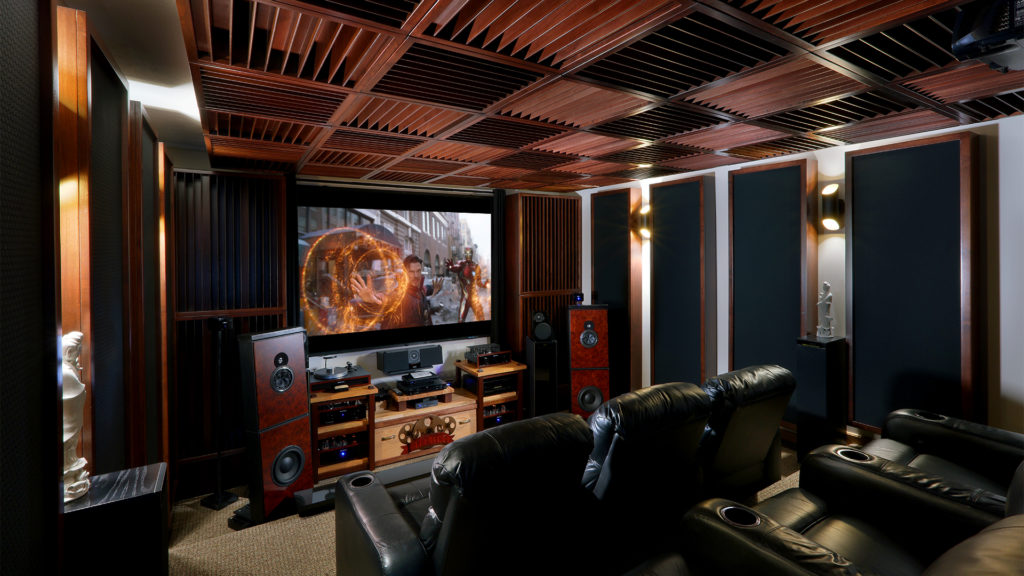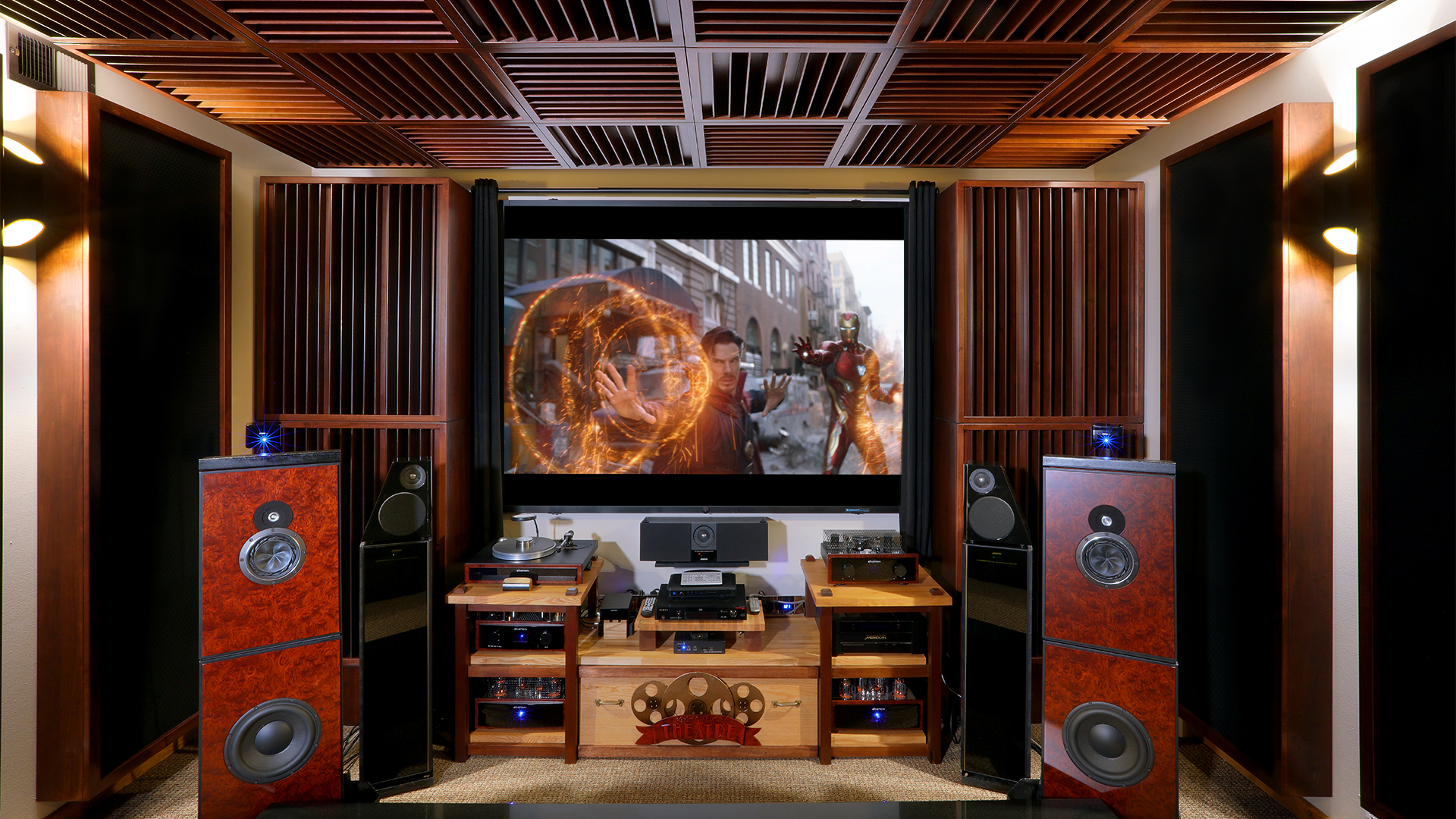Home theater acoustic panels come in many different flavors. We have low frequency home theater acoustic panels. We have middle and high frequency acoustical panels. We have middle and high frequency diffusion home theater acoustic panels. There are panels everywhere and if you believe their manufactures claims, they have a panel that does everything you need. What they fail to realize is that physics is the law and everything else is just a suggestion. What type of home theater acoustic panel you use depends on many variables all of which are directly related to the room dimensions associated with their volumes, the number of channels within the theater, the placement of the seating and a whole host of other issues. Let’s take a look at the biggest elephant within the room first. That would be the low-frequency energy within our theaters. Movies with their associated soundtracks are all about crashes and explosions. The soundtracks have wide dynamic ranges and low-frequency energy usually produced by our subwoofers fills our theater rooms with lots of energy the room does not like.

Small rooms are notorious for low – frequency modal issues. Low-frequency energy below 100 Hz. (bass) fills our theater rooms and some of it will fit into the dimensions of our room and some will not. The parts that do not fit start the air to vibrate between the wall surfaces. This air movement produces audible noise in the form of “bass boom”. This exaggeration of certain frequency modal issues is an axial mode spouting off. Axial modes are the strongest and can be found between two parallel wall surfaces such as a sidewall to sidewall, front to rear wall, and even the floor to ceiling dimension. The floor to ceiling dimension is usually the smallest of the three so it produces the greatest axial modal issues within the room. When you are dealing with 8′ ceilings and low-frequency energy that is 30 – 40″ long, what chance do we have of not producing modal distortion? The next set of modal issues we will have is tangential which occurs between four parallel walls. These are the second strongest and are audible just like axial modes. Oblique modes occur between six wall surface areas and 50% of these can be heard. The bottom line with these modal issues within small rooms is that they must be treated to avoid the audible distortion that they produce. https://en.wikipedia.org/wiki/Room_modes

Axial modes that occur between two parallel surfaces are the most audible. Those modes below 100 Hz. can range from + 5 dB – + 15 dB over flat or baseline. This amount and level of distortion can not be processed electronically. You must treat the room with the proper treatment type, amount, and place that treatment in the proper position TAP. Since our most powerful mode, axial, we must treat at a minimum the two parallel wall surfaces that are showing the largest amplitude (strength) of the unwanted low-frequency modal issues. This treatment technology will take an additional 12″ of wall space to treat. If your starting width room dimensions are say 19′ and need treatment you will end up with a 17′ internal dimension since the treatment takes 12″ of space on each wall surface area. We have a system called the CAW which stands for Carbon absorbing Wall where we build our carbon technology into the walls themselves to avoid large low frequency boxes sitting around within the room. With lower frequency sound absorption management it is all about surface area coverage. You must cover enough surface area of both offending wall surfaces to have an audible and measurable impact of the frequency and amplitude of the modal issues. Placing our carbon technology between the studs allows us to tune the room every 14 1/2″. With this level of micro-pressure management every 14 1/2″ room modal pressure issues do not stand a chance. https://www.acousticfields.com/carbon-absorber-wall/

Tangential modes occur between two sets of parallel walls. They can be sidewalls to sidewalls and front to rear walls. They can be floor to ceiling and sidewalls to sidewalls. They can be front to rear and floor to ceiling. Tangential modes have one half the strength of axial modes but are still audible.http://artsites.ucsc.edu/ems/music/tech_background/TE-02/modes/Modes.html. Tangential modes have a direct impact on middle range frequencies where our vocals are. Tangential modes are part of what we call in physics the speech intelligibility index where we count the number of audible words in a sentence. We try to achieve a 80 % SIR speech intelligibility rating which means that we can hear and understand at least 8 words in a 10 word sentence. This is critical with theater especially after a car crash with dialogue immediately after the car or explosions. With the proper home theater acoustic panels, you should be able to manage the crashes and explosions so that you reduce the “bloom” of low-frequency energy that smothers and blurs our dialogue.

In order to treat your room for all of the issues described above, you will need two types of treatments. You will need our carbon diaphragmatic absorbers for the lower frequencies and our open celled foam for the middle and high frequencies. Our carbon technology took 6 years to develop at a cost of over 3 m. Our foam technology took 8 years and over 2M. There are no finer technologies in the marketplace to deal with full frequency range issues in home theater acoustic panels. Our carbon technology comes in two flavors. For those who wish to absorb down to 30 Hz and up through 6,300 Hz.., we have our ACDA series. https://www.acousticfields.com/product/acda-10-studio/. For those who do not need to go that low but are happy starting at 40 Hz., we have our Activated Carbon Panel that is 4″ thinner than the ACDA series which is a full 16″ deep. https://www.acousticfields.com/product/carbon-panel/. To find out how many and where to place them, fill out the information in this link and schedule a time following the electronic calendar software instructions to speak with Dennis about your individual room needs. https://www.acousticfields.com/free-room-analysis/







